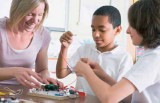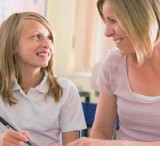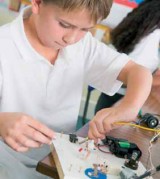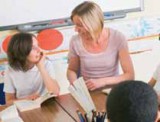Deborah Herridge chews over why we should let our children chat during lessons...
Communication is fundamental to classroom teaching, isn’t it? But in primary science, have you ever noticed that it can become a little one sided? In a subject that thrives on questioning and enquiry, how often it is that teachers end up doing all of the enquiring? There are times when persistent drilling, questioning and telling by the teacher results in narrowly defined responses from pupils – the hope being that this will help children dredge up the ‘right’ answer to test questions. I know, because in my time I’ve had a few science lessons go horribly, like this:
T: OK, now settle down. You need to be listening now. Today we are going to find out about friction. Now we started this last week, so you should all remember. Who can tell me what friction is?
(Some shuffling in seats. Two hands are raised.)
T: Now come on, we did this all last time. (Two more hands go up.)
T: Yes, Joe?
Joe: A force.
T: Yes good, and what else? Anyone?
(Pauses briefly)
T: No-one? Friction is the force that what…? Friction does what to something?
(Looks around expectantly, no hands up.)
T: It sssssss….?
Pauses for one second
T: It ssslo…. Joe? Joe: Slows stuff down miss.
T: Thank you, Joe. Exactly. Friction is a force that slows things down.
T: Now, which of these shows high friction?
(Shows pictures of several situations on whiteboard. Three hands, including Joe’s go up.)
T: Oh dear! I think Joe’s the only one awake today! Right, look at the picture of the child on the slide. Is that showing high or low friction?
(Points to picture)
T: It’s low friction isn’t it.
T: Can anyone think of something that shows high friction?
(No response)
T: What about the trainers? Are the soles of the shoes good for gripping or slipping?
T: I think we’d all better have a big think and draw one example of somewhere we’d see low friction, like the slide, and one example of something with high friction, like the trainers. Off you go, quietly please.
Miss Stride’s class is arranged with rows of tables all facing forwards. Everything is neatly arranged, labelled and laminated. Most of the displays contain information rather than examples of children’s work. Children work in their science books which contain neat and tidy tables of results all completed in their best handwriting. ‘I cannot abide mess,’ says Miss Stride, ‘and to be honest I don’t do a lot of science because the children get so noisy and tend to misbehave. I like a quiet, purposeful and orderly classroom.’
 Now let’s look at another lesson starter:
Now let’s look at another lesson starter:
T: Last week we did some excellent work on diet and we looked at the different sorts of foods we need to keep healthy. We’re going to have a couple of minutes to chat about what we know about healthy diets, but before we do that I want you to think about these different people.
(She brings up photographs of Wayne and Waynetta slob, which produces a few giggles.)
T: Yes, they’re in a bit of a state aren’t they? Talk to your neighbours about what we need to eat to keep us healthy and imagine that you are Wayne and Waynetta’s lifestyle coaches. What advice will you give them on diet and achieving a healthy lifestyle? Remember, no hands up and off you go.
(The teacher turns away from class where children are talking enthusiastically. After five minutes, the teacher returns to the front of the class and waits with finger on her lips. In a moment, the class becomes quiet.)
T: Thank you. Now, I’ll take ideas from Tom’s group.
Tom: We thought that you need a balanced diet with not many sweets or fatty foods in it.
T: A balanced diet, that’s interesting. Who agrees with Tom’s group?
(Thumbs go up)
T: OK. Sara. Does your group have anything to add?
Sara: We need to eat lots of fruit and vegetables and just some carbohydrates like bread and potatoes to stay healthy.
T: I see. Different sorts of foods. Amy I can see your thumb is up – anything to add?
Amy: You need to exercise.
T: Kay, what do you think about Amy’s idea?
(Kay remains silent)
T: I’m going to give everyone a couple of minutes to chat about whether exercise is important for us to stay healthy and then we’ll come back to it.
(Two minutes pass )
T: Kay, I can see your thumb’s up…
Kay: We thought that you need to exercise to stay healthy but that you’d probably need to eat more too if you were exercising a lot.
T: That’s an interesting idea. So you think maybe that you need more food to be able to exercise? I wonder if that’s something we could test in class? How might we find out? What does everyone think – talk to your neighbour…
(Children discuss )
T: Raj?
Raj: We thought you need healthy food, not more food, so we’d tell them to eat pasta and carrots and stuff but not too much. You wouldn’t really be able to test it in class though because it would take forever and you’d have to tell people what to eat all the time. But we could look on the internet or ask someone who is an expert.
T: I see. So it’s not something we can easily test ourselves. Does anyone else have an idea. Have a couple of more minutes chat and we’ll come back.
(More talk…)
T: ... Amy’s suggesting that we could keep a food and exercise diary. That might be an idea to follow up. Thank you. So what we’ve said so far is a range of foods - lots of different types - and taking exercise are two things we think will keep us healthy. Is that what we think?
Class: Yes
T: Good thinking. Now, can we think of any other advice we can give Wayne and Waynetta on staying healthy?
(Chatter…)
 T: I’m hearing, ‘Stop smoking,’ and what else, Ann? Ann: Stop drinking beer! T: Hmm, not too much beer maybe. OK, really good thinking going on. I have some video recorders here and your job, in your groups, is to record a message for Wayne and Waynetta to let them know what to do to keep healthy. We’ll look at them all at the end. You have 20 minutes. Ready? One person from each group collect the recorders and off we go.
T: I’m hearing, ‘Stop smoking,’ and what else, Ann? Ann: Stop drinking beer! T: Hmm, not too much beer maybe. OK, really good thinking going on. I have some video recorders here and your job, in your groups, is to record a message for Wayne and Waynetta to let them know what to do to keep healthy. We’ll look at them all at the end. You have 20 minutes. Ready? One person from each group collect the recorders and off we go.
(Busy chatter and children start to make their video messages)
Miss Merry arranges her class in mixed ability groups seated around tables. Everything is neatly arranged, labelled and easy for the children to access. Most of the displays contain examples of children’s work, which changes on a weekly basis as children have a say in what goes up on the walls. Children work in their science books which contain collections of thoughts, ideas scribbled on post-it notes, and every so often a piece of more formal writing. ‘We can be quite noisy in this classroom,’ says Miss Merry ‘and to an outsider it may seem a bit chaotic but the children all know what they’re supposed to do and just get on with it. I like a busy, purposeful and productive classroom.
Miss Stride is a product of my worst imaginings, but the Miss Merry’s of the world are alive and thriving in our primary science lessons.
 Talking partners are familiar now in primary classrooms but a ‘no hands up’ or thumbs up approach is less widespread. When we don’t have anything to say or worse, don’t know ‘the answer’, it can be hugely intimidating to be surrounded by a forest of hands waving energetically in the air. A thumb up and held close to the chest or a thumbs down is a more personal and private way of communicating thoughts to a teacher but can be seen just as clearly.
Talking partners are familiar now in primary classrooms but a ‘no hands up’ or thumbs up approach is less widespread. When we don’t have anything to say or worse, don’t know ‘the answer’, it can be hugely intimidating to be surrounded by a forest of hands waving energetically in the air. A thumb up and held close to the chest or a thumbs down is a more personal and private way of communicating thoughts to a teacher but can be seen just as clearly.
Given time to think and talk and knowing that an answer or comment will be expected (even when not volunteered), children are encouraged to share their group’s ideas in a nonthreatening atmosphere. Talking together improves critical thinking about science and listening to others’ views helps us to think about our own ideas in a safe environment. And that’s the crucial part – acceptance and real dialogue about children’s ideas with the children themselves. Gradually, your children will develop much more authentic thinking in science and move beyond the predictable scripts of ‘teacher question; pupil answer’.
Present the children with a ‘What if…’ statement, such as ‘What if we lived in a world with no friction?’ or, ‘What if we had eyes on the ends of our fingers?’. Children can then think of, and share by talking, as many positives, negatives and interesting things that such a statement would suggest. This is a great way of stimulating science discussions.
Be positive!
We all need encouragement, and starting with a positive makes us less likely to be on the defensive when told what could be improved. Start by acknowledging what the child has achieved before pointing out what is still to be done.
Be specific!
 Saying, ‘That was great!’ although well meant is so generalised that it becomes meaningless as feedback. Instead of evaluating, develop descriptive praise. Saying, ‘I really liked the way you organised your investigation so that everyone had a part to play;’ and, ‘you have accurately mapped your results onto a graph and correctly labelled the axis,’ makes more of a personal impact than simply saying something is ‘good’.
Saying, ‘That was great!’ although well meant is so generalised that it becomes meaningless as feedback. Instead of evaluating, develop descriptive praise. Saying, ‘I really liked the way you organised your investigation so that everyone had a part to play;’ and, ‘you have accurately mapped your results onto a graph and correctly labelled the axis,’ makes more of a personal impact than simply saying something is ‘good’.
Be honest!
Children always seem to know when teachers are fibbing. There’s not much point saying something was fantastic when secretly you’re thinking it was flipping awful. If we gloss over the negatives, children will continue to make the same mistakes in the future – but worse, they’ll think they’re doing a fantastic job because that’s what you’ve told them.
Name and celebrate!
If we’re giving feedback to the whole class, name the children you caught doing good work. Feedback that is relevant to us as individuals helps us learn better.
Don’t make it personal!
Limit negative feedback to actions or behaviours – not personalities.
Deborah Herridge is Senior Lecturer in Primary Science Education at Northumbria University. Until recently she was CPD Leader for Primary Science at Science Learning Centre North East.
